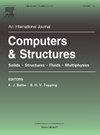基于richardson外推的多边形单元超弹性大变形分析数值积分格式
IF 4.4
2区 工程技术
Q1 COMPUTER SCIENCE, INTERDISCIPLINARY APPLICATIONS
引用次数: 0
摘要
提出了一种基于多边形有限元的超弹性大变形分析方法。与通常用于该问题类型的二次8节点四边形有限元(FEM-Q8)网格相比,在相同的单元数量下,多边形单元网格通常需要较少的节点数量(从而较少的自由度)。传统的PFEM数值积分包括两个步骤:1)将多边形(单元)域细分为三角形单元,2)在三角形单元中进行Dunavant积分方案。每个n-角形域可划分为n个三角形单元。由于问题是非线性的,通常每个三角形单元取三个积分点。因此,每个n形元素需要3n个积分点。或者,理查德森外推与一点规则相结合,产生所谓的(n+1)点积分方案。由于积分点的数量较少,可以实现更快的计算速度,同时保持精度。本文采用PFEM与(n+1)点积分法(RE-PFEM)相结合的方法进行超弹性大变形分析。本文通过几个数值算例说明和评估了所开发的RE-PFEM方法在这类非线性分析中的性能,这在以前的文献中没有报道过。与PFEM和FEM-Q8以及其他方法得到的可用参考解进行了比较。本文章由计算机程序翻译,如有差异,请以英文原文为准。
Polygonal elements with Richardson-extrapolation based numerical integration schemes for hyperelastic large deformation analysis
This paper presents a novel approach based on polygonal finite elements (PFEM) for hyperelastic large deformation analysis. Compared to the mesh of quadratic 8-node quadrangular finite elements (FEM-Q8), which is usually used in this problem type, a mesh of polygonal element usually requires less number of nodes (and thus less number of degrees of freedom), given the same number of elements. Traditionally, numerical integration in PFEM involves two steps: i) sub-division of polygonal (element) domain into triangular cells, then ii) Dunavant's integration scheme is conducted in the triangular cells. Each n-gonal domain could be divided into n triangular cells. Since the problem is non-linear, three integration points per triangular cells are typically taken. As a result, 3n integration points are required for each n-gonal element. Alternatively, the Richardson extrapolation is combined with the one-point rule, resulting in the so-called -point integration scheme. Due to the less number of integration points, faster computation could be achieved, yet accuracy is preserved. Here, the PFEM being incorporated with the -point integration scheme, namely RE-PFEM, is employed for hyperelastic large deformation analysis. Performance of the developed RE-PFEM approach in this type of nonlinear analysis, which has not been reported in the literature before, is illustrated and assessed through several numerical examples. Comparison is conducted with PFEM and FEM-Q8, as well as available reference solutions obtained by other methods.
求助全文
通过发布文献求助,成功后即可免费获取论文全文。
去求助
来源期刊

Computers & Structures
工程技术-工程:土木
CiteScore
8.80
自引率
6.40%
发文量
122
审稿时长
33 days
期刊介绍:
Computers & Structures publishes advances in the development and use of computational methods for the solution of problems in engineering and the sciences. The range of appropriate contributions is wide, and includes papers on establishing appropriate mathematical models and their numerical solution in all areas of mechanics. The journal also includes articles that present a substantial review of a field in the topics of the journal.
 求助内容:
求助内容: 应助结果提醒方式:
应助结果提醒方式:


